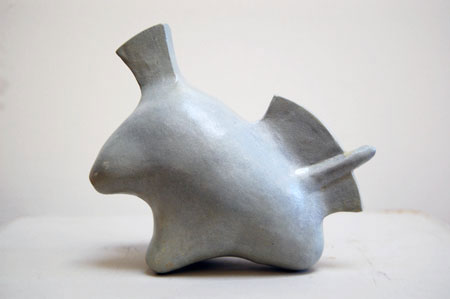Reflections on Art From the Mailbox: Kerry Flaherty’s Unicorn Multiples
09.03.11

The multiples Kerry Flaherty created for Special Delivery presents the latest evolution of the unicorn, a mythological figure that has never held one steady form.
Her herd of 27 unicorns all sport the same Trojan Horse mohawks and simplified tails. The edition is exact in shape but each unicorn differs in color. In a Mighty Morphin’ Power Rangers style, Kerry divided her multiples according to 24 variations of the color wheel. Three pieces of this edition, including the one sent to me, were placed outside the spectrum: one was set in concrete, another was painted black, and mine was set in the most ’90s color of them all, glow-in-the-dark. That makes it grayish in daylight.
Their shapes are also well defined. If tipped backward, the unicorns remain rearing and perfectly balanced in the air. If pushed forward in the opposite direction, the creatures plop face down helplessly stuck with noses pressed to the floor. I’ve yet to see a piggy bank with such a sense of gravity.
For this multiples exchange, Kerry had the impulse to create “a ridiculous amount of variation” on one object. This object she’s chosen lead me to a slightly obsessive search on this imaginary animal and its evolving presence in art.
Unicorns might be seen as a gauge of ourselves. As one character from Haruki Murakami’s Hard-Boiled Wonderland and the End of the World ponders, “the unicorn remains an imaginary animal, an invention that can embody any value one wishes to project.” That character had been performing his own unicorn research, studying Eastern and Western variations. Murakami’s entire novel seems like a love letter to the unicorn, the “golden beasts” whose hoofbeats can be heard throughout the book. It had been a very enjoyable text to use as unicorn research. I should go after Murakami’s footnotes, for he incorporated some curious sounding sources like Jorge Luis Borges’ Book of Imaginary Beings.
Author Trinie Dalton, might be the next best expert to consult on unicorn matters of the past 3 decades. In addition to writing a fictional piece intended for young audiences on the subject, Dalton compiled “A Touch of Class.” This zine documents unicorns via low-art objects, what she has referred to as “freak folk stuff.” For example, the zine includes an essay on Brian Eno, an overly detailed history of ’80s and ’90s unicorn stickers, photos of tattoos, drawings, some mention of disco, and just plain odd-ball information on unicorn sightings.

Kerry’s Unicorn Spectrum is a relative of the freak folk culture in Dalton’s zine. These squat creatures recall piggy banks and chubby English bulldogs. With the right color palette, they could also morph into an accessory for the Power Puff Girls. Or take away some pigment, add earthly tones, and you might find the silhouette of a mythological type of Chia-Pet. This list of associations could easily continue, probably because Kerry graced her unicorn herd with a characteristic that connects many of today’s consumer products—cuteness.
After receiving Kerry’s piece, I couldn’t help but recall Ted Enik’s illustrated lecture, Cutegasm!. Given last summer at The Observatory, Enik discussed a mix of writings by journalists and scholars studying “how we have all been willingly polluted by the CUTE” while presenting images of cartoons, toys, photographs, and fashion. Topping Enik’s list of sources was the essayist Daniel Harris, whose ideas and work from Cute, Quaint, Hungry, and Romantic guided the discussion towards a hidden sadism present in Cute Addiction.
As an author and illustrator of children’s books, Enik has long been familiar with the evolution of cartoon characters. He can confirm that many of them evolve towards bright-eyed, baby-beings. In Enik’s talk, he suggests that there are market forces behind this juvenilization. Because research shows that we are chemically wired to respond to things that appear helpless or infantile, advertisers and marketers will consciously improve the design of a product by making it cuter, thus attracting a greater audience of consumers.
I’ve sent Enik a picture of Kerry’s unicorn multiple. As an experienced observer on Cute matters, Enik felt that the object wasn’t as cute as he imagined from our previous email exchanges. For Enik, the chubbiness of the piece—which I may have naively deemed a signifier of the Cute—recalls the abstraction present in the paintings of Fernando Botero. I’m starting to agree with that view. Enik’s Cute Observations, especially the darker side of the Cute Pollution, seem more connected with the evolution of the unicorn, rather than Kerry’s specific edition. There’s an atrociously cute unicorn sticker in Dalton’s “A Touch of Class” that might even be too much for Enik. It depicts a smiling rainbow-maned unicorn atop a glossy hamburger the size of a palm tree. Inside the burger, there are sparkly slices of cake, sprinkles, cherries, and other candy bits to go with the burger meat and buns.
Appropriately in an anthology called Mythym, Dalton incorporated her zine on unicorns alongside a zine focused on the prevalence of mirrors in horror films. Mirrors are one way to look at human beings; art pieces are another type of mirror. I’ll posit that unicorns are actually humans in disguise. They’ve appeared in forms of art for hundreds of years and whenever they surface, they certainly become worthy of some reflection.
To end this, I should bring up a moment from Through the Looking Glass when Alice initially meets the Unicorn, of The Lion and the Unicorn. Both stand in momentary disbelief and then refer to one another as “fabulous monsters.”
“If you’ll believe in me,” says the Unicorn, “I’ll believe in you. Is that a bargain?”
One senses the presence of a mirror here. When discussing myths, legends, sci-fi, or fantasy, we are never speaking about anything so super human, as we are actually speaking about ourselves.
—Audrey Tran